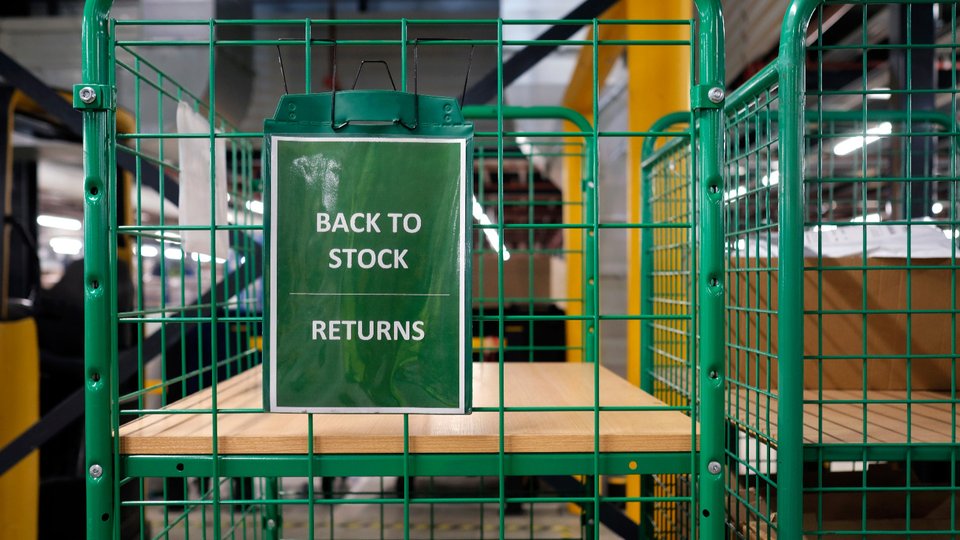AI
How AI can help better manage retail returns
How can retailers improve their returns management processes while delivering the hassle-free returns experience customers expect? With the help of AI retailers can get an upper hand on returns year-round.

February 20, 2024 | Jeanne Yaeger Senior Advisor, Solutions Strategy Antuit.ai, a Zebra Technologies Company
The 2023 holiday shopping season proved to be a winner for retailers. The U.S. Census Bureau data shows core retail sales increased 3.9% from 2022, for a record $964.4 billion, and total sales for the year grew 3.2% to $5.13 trillion, setting yet another record.
But as much as shoppers love to shop, they also love to return items, especially when it comes to online purchases. A recent report by the National Retail Federation found 2023 merchandise returns added up to $743 billion for a total return rate of 14.5%. When looking just at e-commerce sales, it's an even more expensive problem with the cost of returns hitting $817 billion in 2022 according to Statista. And, it's only growing along with online shopping where 30% of all products ordered online are returned, as compared to 8.89% in brick-and-mortar stores, Gitnux research found.
Most consumers (82%) prefer retailers who offer easy returns while most retailers (81%) say managing online returns is a significant challenge as reported in Zebra's recent Global Shopper Study. It's a conundrum. Returns are expensive, labor intensive and open the door to other issues like returns fraud. Yet, Statista reports 78% of U.S. consumers indicate a poor returns experience will make them less likely to shop with a retailer.
How can retailers improve their returns management processes while delivering the hassle-free returns experience customers expect? With the help of artificial intelligence retailers can get an upper hand on returns year-round, from the holiday surge and beyond.
Meet returning customers where they are with AI
E-commerce has changed the rules of the returns game. Take "bracketing" or purchasing multiple colors or sizes of an item online, determining which one to keep when items are received and then returning the rest. Most consumers (63%) say they have bracketed when shopping online. And as more shoppers choose to return online purchases in stores, it's becoming a bigger headache for retailers.
Wardrobing — also known as returning used merchandise — or returning stolen items or merchandise purchased fraudulently are other common returns issues retailers face. While retailers have increasingly tightened their return policies, it comes at the risk of unhappy customers. The bottom line is returners are going to return. And they're going to be loyal to the retailers who make this process easy for them.
Retailers can streamline the returns process, including bracketing and other fraudulent returns scenarios by leveraging AI. For instance, if an associate isn't familiar with merchandise being returned, or customers have questions about a retailer's return or refund policies, associates can simply ask their AI (typically enabled on their mobile device). AI then runs a contextual-based search to find an answer to the question and provides a response in lightning speed, saving time and smoothing out any potential processing challenges. The end result enables associates to quickly access information and provide a better returns experience for customers.
AI predicts merchandise with high return rates so you can prevent them
Using AI predictive analytics can also help retailers reveal merchandise with high return rates. Similar to analyzing a customer's returns data, it can analyze at the item level to identify product patterns or trends. The data could point to quality or sizing issues, for example, or identify if the online product description was misleading. In either case, retailers can take steps to correct the issue uncovered, whether its resizing, improving quality and product descriptions, or even pull the product, to prevent further returns.
Retailers can also better optimize inventory through AI demand planning. It enables retailers to predict merchandise return rates and adjust inventory levels accordingly. When a product is predicted to have a higher return rate, retailers can plan on keeping less of that product in stock. But a low return rate would mean maintaining a higher level of inventory. This insight gives retailers the ability to plan and get inventory levels just right, reducing returns and costs as well as improving overall efficiency.
Analyze, understand and predict customers' returns
Return practices like bracketing and wardrobing are known reasons for returning merchandise. But what about the unknown reasons? Why do consumers return items? Are they the dreaded habitual or "frequent returners" or did merchandise they purchased simply not work? Retailers can gain insights on why customers are returning items through AI analytics.
AI can analyze a customer's past purchases and returns and identify patterns or trends which indicate or predict if a customer is more likely to return purchases. Once a retailer better understands why a customer is returning items, they can take steps to help prevent it.
For example, let's say AI uncovers a pattern showing a customer who often purchases and returns clothing (the most frequently returned merchandise) in a certain size, color or style. Leveraging AI's power of personalization, a retailer can recommend other sizes, brands or styles for the customer to consider. Wakefield Research found most online shoppers (84%) say personalization influences their purchases, so it's likely consumers will purchase recommended options, minimizing the risk of return due to the size, color or style AI has uncovered as an issue.
AI is like your retail intuition- only better
Intuition is inherently part of decision-making in business. Your "gut" may instinctively tell you what you should do to improve your store's returns process. But it's not humanly possible to predict with certainty what customers may return and how frequently, or which products might have flaws or simply don't resonate with customers.
But it is possible to predict with AI. It's possible to anticipate customers' return patterns, optimize inventory and turn AI insights into action to minimize returns, yet still provide the returns experience customers expect every time.





